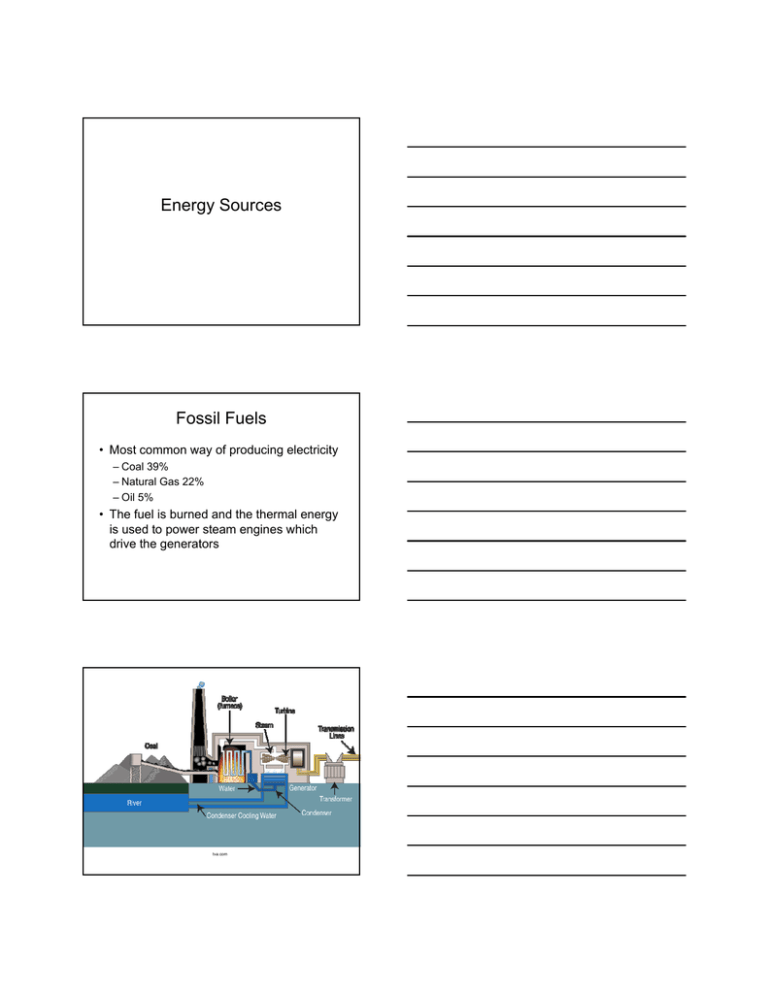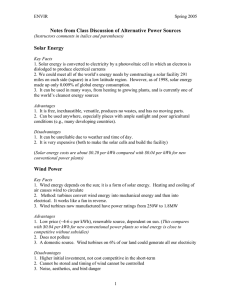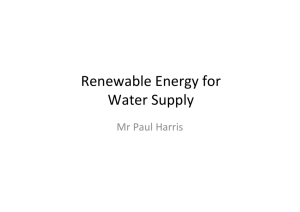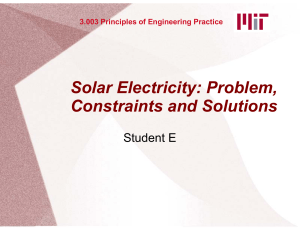Energy Sources Fossil Fuels
advertisement

Energy Sources Fossil Fuels • Most common way of producing electricity – Coal 39% – Natural Gas 22% – Oil 5% • The fuel is burned and the thermal energy is used to power steam engines which drive the generators tva.com Advantages • Relatively cheap • High energy density • Variety of engines and devices use them directly and easily • Extensive distribution network is in place Disadvantages • Will run out – ~70 years for conventional oil and 250 – 350 years of coal • Pollute the environment – The pollution comes from incomplete burning and from impurities in the fuel – Technology has greatly decreased the amount of harmful emissions from burning fossil fuels • Emit greenhouse gases – That’s what happens when you burn something – Human contributions to the amount of greenhouse gasses in the atmosphere is a very small proportion of natural contributions Hydroelectric Power • Oldest and most established source of electrical power • Power is generated from water falling over (or through) a turbine connected to a generator • 17% of the world’s electricity is hydroelectric www.brighthubengineering.com/fluid-mechanics-hydraulics/7120-components-of-hydroelectric-power-plants-part-one • A pumped storage system takes the water that flows through the turbine and pumps it back up to its original height • This takes power and lowers the overall efficiency of the power plant • This technique is used to store power until it is needed www.tva.gov/power/pumpstorart.htm • Power produced is a result of a mass of water, m, falling from a height, h, during a period of time ∆t P mgh t But the volume of water is more important. So… m V P or m V Vgh t V is referred to as the volume flow rate, Q t P Qgh Note: This assumes 100% efficiency Advantages • “Free” – Ignoring the cost of construction, equipment, and maintenance • Inexhaustible • Clean – Ignoring what happens during construction and the flooding that occurs Disadvantages • Very dependent on location • Requires drastic changes to the environment – Not necessarily a bad thing • Initial costs high – This is not unique to hydroelectric dams Nuclear Power • Nuclear fission produces thermal energy which is used to produce steam to drive generators • 11% of electricity world wide is produced by nuclear power whatisnuclear.com/articles/nucreactor.html Advantages • High power output • Large reserves of nuclear fuels • No greenhouse gasses produced Disadvantages • Radioactive waste products are difficult to dispose of – There is actually very little waste and governments have refused to pay for research into the long term storage and disposal of waste • Major public health hazard should something go wrong – Longstanding myth • Major public health hazard should something go wrong – Longstanding myth – There have only been three major nuclear accidents (Three Mile Island, Chernobyl, Fukushima) and the resulting “damage” was completely contained; there was no wide spread environmental or human issues • Problems associated with uranium mining – No more than any other mining operation • Possibility of producing materials for nuclear weapons – This is a real concern if the reactor uses enriched uranium – This problem would be eliminated by using Thorium as a fuel Wind Power • Windmills directly turn a generator • 3% of the world’s electricity is generated by wind • The windmills used to produce a few megawatts of electricity are huge (vanes are larger than 30 m) • Serious power production from wind requires constant wind speed of 6-14 ms-1 www.theinnovationdiaries.com/1146/windmill-power/ • A mass of air, m, passes through an area, A, with a velocity, v, in time ∆t • The density of the air is ρ • In ∆t, the wind travels a distance v∆t, giving a volume of Av∆t • The mass of air is thus ρAv∆t • Calculating the kinetic energy of this air gives 1 2 1 1 mv Avt v 2 Atv 3 2 2 2 • The power generated by the wind turbine is therefore P 1 Av 3 2 Note: This assumes that 100% of the wind’s kinetic energy is converted to power. (Only about 35-45% of the wind is actually captured by the windmill.) Advantages • “Free” – Ignoring equipment and other costs • Inexhaustible • Clean – Ignoring manufacturing Disadvantages • Works only if there is wind – And only if the wind’s velocity is in a specific range • Aesthetically unpleasant • Noise problems – The turbines produce a constant low frequency hum when they are in operation • The initial and maintenance costs are high – A personal turbine producing 538 kWh a month (about 1/3 of what an average household uses) in ~19 kmh-1 wind is $7800 – 8500 (plus tower, other electronics, and installation) • Kill bats and birds – US wind turbines kill 75 000 – 275 000 birds per year (some of these are protected species like bald eagles) Solar Power • Solar Heating Panel – Sunlight heats water (or air) for heating a house – Normally used to heat water in a hot water tank (A)- passive system (B)- active system with solar power pump • Photovoltaic Cells – Developed in 1954 at Bell Laboratories – Used extensively in the space program to power satellites – Sunlight incident on the panels releases electrons and establishes a potential difference across the cell – Efficiency ~30% – Less than 1% of electricity is generated by solar power world wide Solarkraftwerk Waldpolenz, the first Solar 40-MW CdTe PV Array installed by JUWI Group in Brandis, Germany (Photo courtesy of JUWI Group) Advantages • “Free” – If we ignore the cost of all of the equipment • Inexhaustible – Except when its night (or cloudy) • Clean – Ignoring the manufacturing process and batteries that are necessary for storing power Disadvantages • The sun is not always shining – Does not work when it is cloudy or night • Low power output – ~30 V, ~7 A – Output is DC which must be converted to AC with an inverter • Requires large area – An average house (using 30 kWh a day) would need at least 30 3’x6’ panels covering an area of 540 sq ft. • Initial startup costs high – A system with 30 panel (producing 22 kWh/day) would cost $30 000 - $40 000 plus the extra cost needed to attach to the electrical grid for the remaining 8 kWh of power needed • Solar Thermal – Mirrors focus sunlight onto boilers generating steam which drives a generator www.energy.ca.gov/siting/meetings/2010-01-22_meeting/presentations/BrightSource_Energy-Ivanpah_Project_Overview_2010-01-22.pdf Aerial photograph of Ivanpah Solar Power Facility (Craig Butz) Ivanpah Solar Power Facility generating power on April 29, 2013 (Aioannides)




